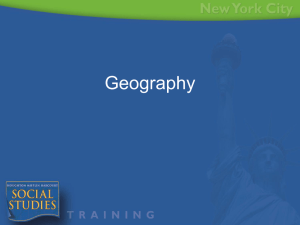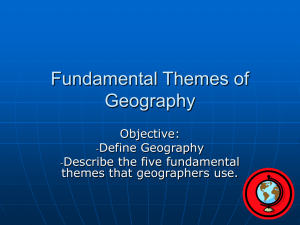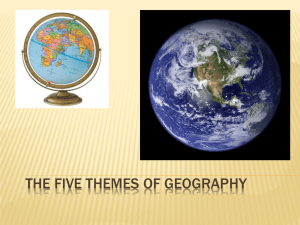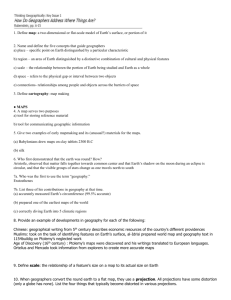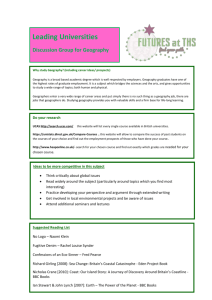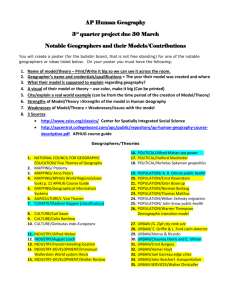Chapter 1: A Geographer's World Packet
advertisement
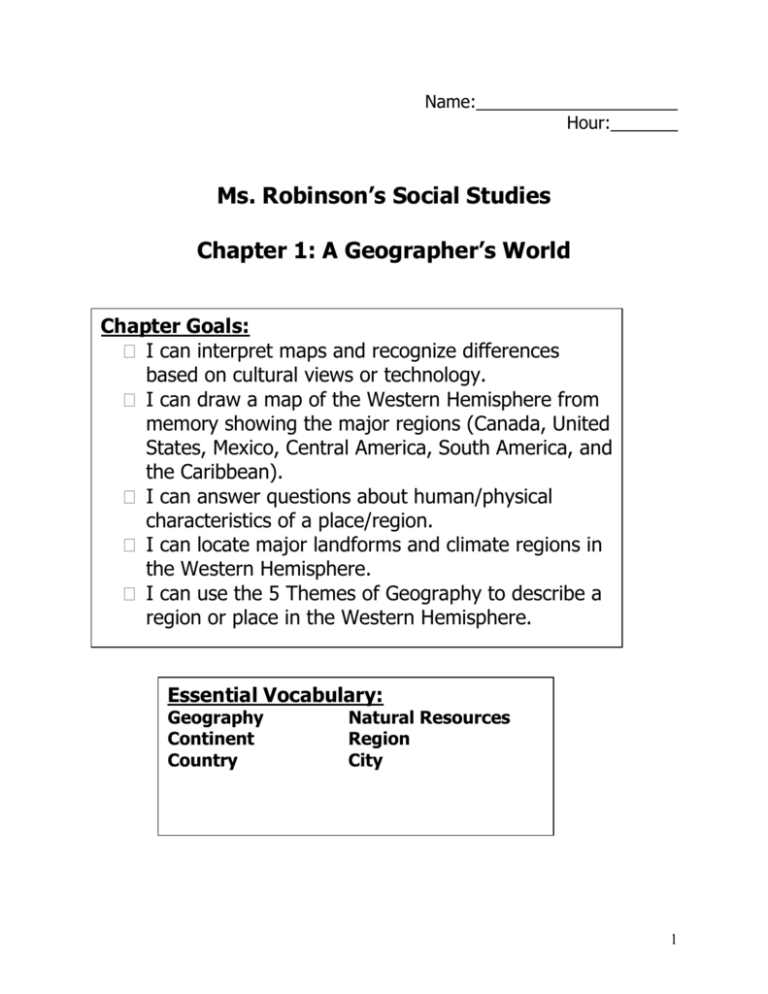
Name:_____________________ Hour:_______ Ms. Robinson’s Social Studies Chapter 1: A Geographer’s World Chapter Goals: I can interpret maps and recognize differences based on cultural views or technology. I can draw a map of the Western Hemisphere from memory showing the major regions (Canada, United States, Mexico, Central America, South America, and the Caribbean). I can answer questions about human/physical characteristics of a place/region. I can locate major landforms and climate regions in the Western Hemisphere. I can use the 5 Themes of Geography to describe a region or place in the Western Hemisphere. Essential Vocabulary: Geography Continent Country Natural Resources Region City 1 Section 1: Studying Geography Concept Map Notes: Fill in the Graphic Organizer with important information which tells us more about what is inside the bubbles. (You can add more arrows if you want) What is Geography? What do Geographers study? What tools do Geographers use? 2 Section 1 Vocabulary Builder: Read the FALSE statements below. Replace each underlined word with one from the word bank that makes each sentence TRUE. globe landscape map social science region geography computer programs 1. A globe is a flat drawing of the earth’s surface. ________________________________________________________ ________________________________________________________ 2. The study of the world, its people, and the landscapes they create is called government. ________________________________________________________ ________________________________________________________ 3. Geography is sometimes called a physical science because it studies people and the relationships among them. ________________________________________________________ ________________________________________________________ 4. An example of a small landform that geographers might study is Chinatown in San Francisco. ________________________________________________________ ________________________________________________________ 5. A map is a spherical model of the entire planet. ________________________________________________________ ________________________________________________________ 6. The combination of human and physical features that make a place unique is called a community. ________________________________________________________ ________________________________________________________ 7. Satellite images help geographers to create, update, and compare maps. ________________________________________________________ ________________________________________________________ 3 Section 1 Questions: Answer the following questions to the best of you ability. Please use complete sentences for question 1-3. Please fill in the Venn Diagram for question 4. 1. Why is geography considered a science? 2. What global issues do geographers study? 3. How do geographers use satellite images? 4. Fill in the Venn diagram. Use at least 3 points from each section. Maps Globes Similar 4 5. Draw your own map of the Western Hemisphere with out looking at your book. Use as much detail as you can. This is a practice map and will not be counted for a grade, however, you must try. 5 Section 2: Geography Themes and Essential Elements Geography and the Five Themes Guided Notes What is Geography??? ________________________________________________________ _______________________________________________________ MR. LIP M _________________________ R _________________________ L _________________________ I _________________________ P _________________________ Movement - ______________________ - ______________________ - ______________________ People People interact with ______________________________ through movement Goods The movement of ______________ and ________________ goods and communication have played major roles in shaping our world. 6 Ideas Not only do humans move but also ideas move; ________________ move; ___________________ move. Region -_________________________ – defined lines and borders -_________________________ – has a function, particular area/region for a paper route. -_________________________ (perceptual) – people’s perception What is a region? _______________________________________________________ ________________________________________________________ Formal regions Defined by ______________________ Example: United States, Novi, Great Britain. These regional boundaries are not open to dispute, therefore physical regions fall under this category Example: The Rockies, the Great Lakes States. Functional regions Defined by a ___________________________ Example: United Airlines Service area or a newspaper service area. Vernacular regions Loosely defined by _______________________________________ Example: The South, The Middle East. Downtown Kentwood 7 Location -_______________________ Location – about/in comparison to… -_______________________ Location – using longitude and latitude Absolute Location ____________________ and ______________________ (a global location) or a ______________________________________ (local location). Paris, France is 48.51' North latitude and 2.20' East longitude Relative Locations ____________________, time, direction or ____________________ from one place to another and may associate a particular place with another. Human-Environmental Interaction -Humans ___________________ to the environment -Humans ___________________ the environment -Humans ___________________ on the environment Adapt People adapt to the environment by __________________________ that is suitable for summer and winter; rain and shine. Modify People modify our environment by __________________ and _________________________ buildings for comfort or dig tunnels for railroads. Depend 8 People depend on the Great Lakes for our __________________ and ___________________________. Place -________________________ Characteristics – natural landforms, bodies of water, etc. -________________________ Characteristics – man made Physical Characteristics Mountains, rivers, soil, beaches, wildlife, etc. Human Characteristics Buildings, roads, clothing, and food habits. Five Themes Mini Project: Ms. Robinson will assign you a theme. Fill in the boxes below for your theme. Have your table partner review your theme. Definition: __________________________ Example In Kentwood: _______________ ____________________________________ ____________________________________ ____________________________________ ____________________________________ PICTURE 9 Five Themes Mini Project Continued: Redraw your theme picture on a half sheet of paper. White the definition of lined paper or type and print it. Select a sheet of colored paper and write your name and hour on the back. On the top front of your colored paper, write your theme as a title. Glue your picture and definition below you title. Section 2 Vocabulary Builder: DIRECTIONS Read each set of four vocabulary terms. Cross out the term that is not part of each set. 1. a. absolute location b. relative location c. specific description d. 6 Elm Street, Nome, Alaska 3. a. water b. land c. specific description d. environment 2. a. absolute location b. relative location c. general description d. north of Portland 4. a. location b. place c. movement d. human systems DIRECTIONS Use the five vocabulary words to write a summary of what you learned in this section. ____________________________________________________________ ____________________________________________________________ ____________________________________________________________ ____________________________________________________________ ____________________________________________________________ ____________________________________________________________ ____________________________________________________________ ____________________________________________________________ ____________________________________________________________ ____________________________________________________________ 10 Section 3: The Branches of Geography Geography Cornell Notes Pg. 16-20 Topic: Themes: Details: Summary: 11 Section 3 Vocabulary Builder: Read each sentence and fill in the blank with the word in the word pair that best completes the sentence. 1. ________________________ is the study of weather and what causes it. (Cartography/Meteorology) 2. Geographers might study ________________________ if they want to know how Victoria Falls formed. (physical geography/human geography) 3. Without ________________________, geographers would not be able to use maps to study where things are in the world. (cartography/ meteorology) 4. The study of Earth’s people, including their way of life, homes, cities, beliefs, and customs is called ________________________. (physical geography/human geography) 5. Studying the world’s river systems and how to protect the world’s water supply are important parts of ________________________. (hydrology/meteorology) ***Use this packet to review for your Chapter 1 Assessment. *** 12
